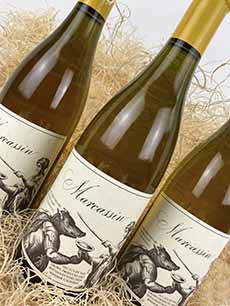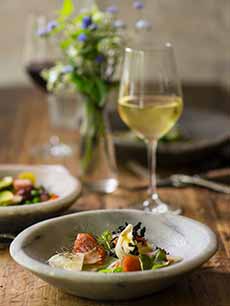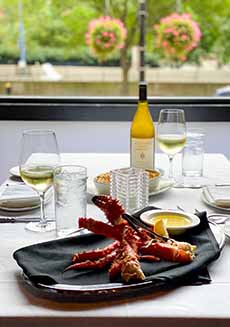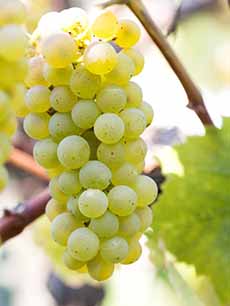It’s National Chardonnay Day, The Most Popular White Wine
|
May 27th is National Chardonnay Day, and International Chardonnay Day is celebrated on the Thursday before the last Monday in May. That may sound complex, but it’s the Thursday before Memorial Day. So…time to open a bottle! Chardonnay is the world’s most popular white wine: a dry, medium- to full-bodied wine with moderate acidity and alcohol levels. It can be grown in a variety of climates. Between the terroir and the winemaker, Chardonnay can have different personalities. > The history of Chardonnay is below. Due to the wide range of styles, Chardonnay can be paired with a diverse spectrum of food types. Thanks to La Crema, maker of great California Chardonnay, for these tips: DO Pair Chardonnay With: The Chardonnay grape, a green-skinned white wine grape, originated in the Burgundy region of France, and Chardonnay from Burgundy is the world’s most expensive. It is the grape that makes the great Burgundies Chablis, Meursault, Montrachet, and Pouilly-Fuissé. Chardonnay is also one of two primary base grapes for the sparkling wines of Champagne, along with Pinot Noir and the blending grape, Pinot Meunier. The grape takes its name from a commune (small town or village) in the Mâconnais region of southern Burgundy, which today makes relatively simple, inexpensive Chardonnays. The name of the town derives from cardonnacum, the “place full of thistles.” The commune recently celebrated its thousandth anniversary From there, Chardonnay most likely was then spread throughout France by Cistercian monks. The grape reached its apex when it moved north to Burgundy, where the cooler climate and the overall terroir were perfect to elevate the complexity of the grape. The earliest recorded reference to Chardonnay occurs in 1330. Cistercian monks built stonewalls around their Clos de Vougeot vineyard in Burgundy, exclusively planted with Chardonnay grapes [source]. Chardonnay is a crossbreed. Many centuries ago, growers in the Chardonnay area created the Chardonnay grape by crossing their local Pinot Noir grape with Gouais Blanc (Heunisch), a white grape thought to have brought by the Romans from Croatia. It was widely cultivated by peasants in eastern France [source], and the wine immediately became a local favorite. But it wasn’t until the 14th century when the Cistercian monks popularized it to make their wine in Burgundy [source]. It has long been the second-most-planted white wine grape in France.* |
|
|
|
Chardonnay Today While there were several claims to Chardonnay’s “true” origins, modern DNA fingerprinting by Dr. Carole Meredith at the University of California, Davis, has finally identified Chardonnay as the cross between the Pinot Noir and Gouais Blanc grape varieties. If you’ve never heard of Gouais Blanc, it’s because it’s nearly extinct grape. Wine made from Gouais Blanc was not well liked even back in the day. It has been actively dug up over the centuries, its vineyards replanted with other varieties, leading to its now “nearly extinct” situation [source]. But we are grateful that it was around when needed to create one of the great wine grapes of the world. Chardonnay, Gamay Noir, and many other classic varieties† can be traced back to this cross of Pinot and Gouais Blanc. Today Chardonnay is planted the world over. In the U.S., the grape is grown in Northern California, Washington State, and Oregon—the three largest plantings in the U.S.—New York State, Texas, and Virginia. Chardonnay is the most widely planted white variety in California, on a par with the plantings of Cabernet Sauvignon. Wine trivia: Ampelography is the field of botany concerned with the identification and classification of grapevines. Traditionally this was done by comparing the shape and color of the vine leaves and grapes; however, the field has been revolutionized by DNA fingerprinting. *The most planted white wine grape in France is Ugni Blanc, an Italian grape from Tuscany, where it is known as Trebbiano. It largely used to make brandy in the Cognac and Armagnac regions of France. †Grape varieties that trace back to Gouais Blanc and Pinot include Aligoté, Aubin vert, Auxerrois, Bachet noir, Beaunoir, Dameron, Franc noir de la Haute, Saône, Gamay blanc Gloriod, Gamay noir, Knipperlé, Melon, Peurion, Romorantin, Roublot and Sacy. That’s a lot of relatives! [source] CHECK OUT WHAT’S HAPPENING ON OUR HOME PAGE, THENIBBLE.COM.
|
||









